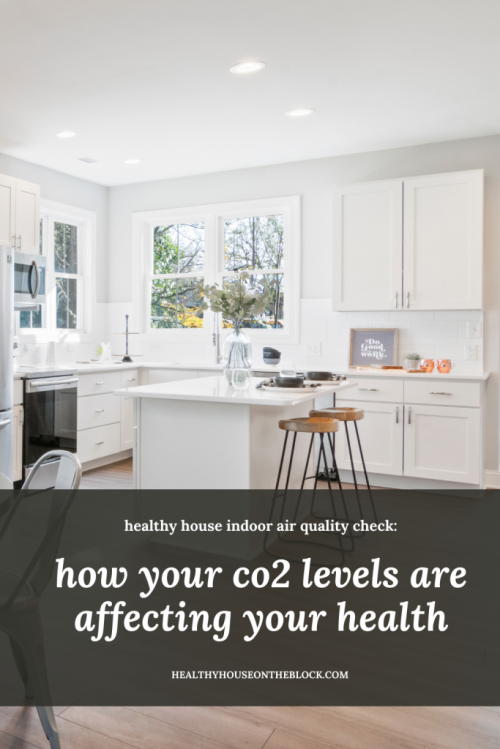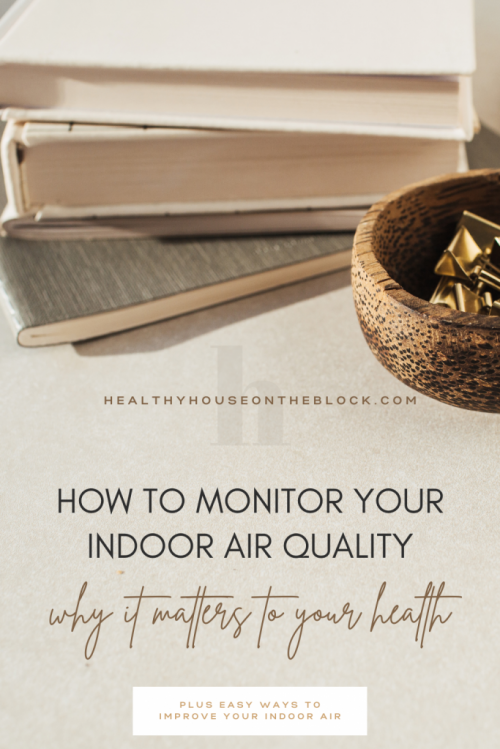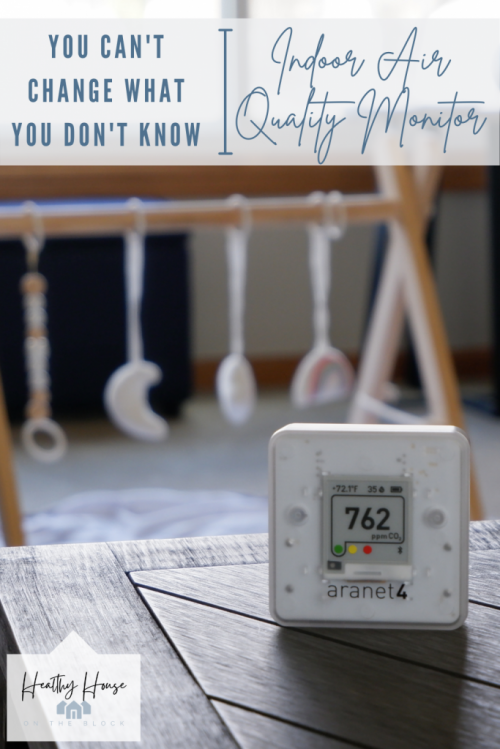
Over the past year, indoor air quality has become a huge topic. What we’ve learned from the spreading of the COVID-19 virus is that indoor air quality plays a HUGE role in the transmission of this virus. And one of the ways we can monitor indoor air quality and specifically the risk of transmission is by monitoring the CO2 levels at home.
I know for my family personally we have always had a pretty good pulse on our indoor air quality and really tried to make sure our house was well ventilated. But it wasn’t until recently that we really kicked our indoor air quality efforts up into high gear. With bringing home a baby with some medical needs and keeping our girls as healthy as possible while they returned to in-person school, indoor air quality became a focus.
The first step to REALLY getting a good handle on indoor air quality is to understand what’s going on with your air in the first place. You can’t fix what you don’t know. One of the best ways to do this is to use an indoor air quality monitor. I’m going to share with you today the Aanet4Home, which has several different ways it monitors the indoor air — including monitoring your CO2 levels.
But first, it’s important to understand WHY we monitor CO2 levels and how these elevated levels can affect your health and home.
WHAT IS CARBON DIOXIDE AND WHERE DOES IT COME FROM?
Carbon Dioxide, or CO2 as we often refer to it is actually a greenhouse gas that is a natural part of human nature and earth. In small quantities it’s very harmless and it’s actually one of the most important gasses on the earth.
Plants use carbon dioxide in the photosynthesis process, which is a natural and necessary process for plants to grow and thrive. Without the photosynthesis chain, we would have no food or vegetation on the earth — a necessary part of our survival.
Indoors: Humans produce carbon monoxide through breathing and respiration. Outdoors, the CO2 level isn’t impacted by our breathing, but indoors carbon dioxide can build up in the air and become concentrated in closed spaces or when there is overcrowding.
Gas appliances that have an open flame also produce CO2 inside the home. Fire is a natural chemical reaction that uses oxygen and as a result produces carbon dioxide, and sometimes elevated CO2 levels. Sources of open flames in your home may be gas or wood fireplaces, gas stoves and candles. (but don’t confuse this with carbon monoxide, which is also produced by gas burning appliances in the combustion process)

Soil: As organic matter decomposes, it releases carbon dioxide. Most of this will dissipate outdoors, but in some cases, CO2 can seep into your home — especially if you have a level that is underground, like a basement. It’s particularly important to know if your home is built on areas that were previously used for farming or mining operations, as the CO2 levels can be even higher.
Outdoors: CO2 levels are also elevated by the burning of fossil fuels, which are emitted into the atmosphere by various human activities such as burning oil, coal or gas. While carbon dioxide poisoning doesn’t often occur outdoors in the atmosphere, it’s still important to know that this is another type of exposure.
CARBON DIOXIDE POISONING & HEALTH EFFECTS:
Carbon dioxide is dissolved in the lungs, just like oxygen and transported throughout the body by our bloodstream. As CO2 enters the bloodstream, it lowers the pH of blood and causes an imbalance in electrolytes and in turn affects multiple systems throughout the body due to the imbalance. (CO2 FACT SHEET)
While carbon dioxide poisoning is rare, there are other health effects that can be experienced due to high CO2 levels. Indoors, carbon dioxide can become concentrated, leading to high CO2 levels. These high levels of carbon dioxide can lead to long term problems such as:
- Inflammation
- Reduced cognitive performance
- Kidney calcification problems
- Bone demineralization problems
What’s even more is that the constant exposure to CO2 in the atmosphere appears to be a stressor on the body that is constantly eating away at our bodies and systems. (STUDY).

There are also short term health effects that someone may experience when carbon dioxide levels are too high:
- Headaches
- Dizziness
- Pins & needles feeling
- Difficulting breathing
- Tiredness
- Increased heart rate
Another thing we know about high levels of CO2 is that oftentimes the high levels indoors are coming from our breathing. As a general rule of thumb, the more higher the CO2 levels, naturally, the more germs and bacteria are also in the air from our breathing. You could probably guess that a home with better ventilation and lower CO2 levels will also have air that contains fewer viruses and bacteria.

BEST WAY TO MONITOR CO2 LEVELS AND WHY
More than just the obvious reasons why monitoring indoor CO2 levels is important (to avoid the health effects I mentioned earlier); you can also monitor the overall health of your indoor air. One saying goes, “you can only change what you know”. If you don’t know that your indoor air quality is poor, there’s no reason for you to ever improve it or change it.
Indoor spaces with high CO2 levels are also spaces that generally have high levels of virus threats to those in the space. Specifically, by monitoring carbon dioxide, indoor spaces were able to lower the threat of COVID-19, Coronavirus by preventing the build up of reused air. This is why so many schools and public buildings have been implementing this monitoring strategy within their indoor spaces. (STUDY)
Once you know exactly what your indoor CO2 levels are inside your home, you can begin to make small changes to your habits and indoors spaces to reduce the CO2 levels when and where necessary.
CO2 levels indoors should ideally be below 1,000 (ppm) parts per million.

ARANET 4 HOME INDOOR AIR QUALITY MONITOR
I was contacted by CO2Meters to try out one of their ARANET4HOME CO2 monitors in my own home as an indoor air quality monitor. Their devices are used in homes, business and schools — in fact it’s even used at the University of Minnesota to monitor indoor air quality.
Not only does it tell you what the indoor air quality is with a number measurement, but it also indicates if it is “Good”, “Average” or “Unhealthy”.
It also has bluetooth so you can connect it to your phone via an app to monitor your indoor air and see a chart of how it has fluctuated over a time frame.

Carbon Monoxide Measurement Reading: The Aranet 4 Home monitor is constantly measuring the carbon monoxide inside the space you choose. It monitors the aerosols in the air, which also indicate the potential for viruses, even the COVID-19 virus and bacteria in the air. You can program the monitor to read CO2 levels every 1 minute, 2 minutes, 5 minutes or 10 minutes depending on what you’d like for your indoor space.
Temperature: Besides monitoring CO2 levels, the Aranet4Home has a temperature display. As I’ve mentioned before, the temperature in our homes actually plays a part in the indoor aur quality and the overall climate of our home. VOCs (volatile organic compounds) off gas at a higher rate in warm environments and so keeping your home at a lower temperature that is still comfortable is key.

Relative Humidity: SO much of our home’s health is based on the relative humidity. If you missed this post, it talks all about the indoor humidity levels at home and how to keep them an ideal level. An environment at home that is too humid will cause VOCs to off gas at a higher rate as well. It also promotes mold and mildew growth as well as dust mite breeding.
On the other hand, relative humidity that is too low will cause static electricity and issues with wood finishes shrinking and increased risk of illness. By monitoring and knowing what your indoor humidity levels are, you’ll be able to control them better and keep them at the ideal level.
Atmospheric Pressure: Every house has either positive or negative pressure inside it. This atmospheric pressure is determined by the energy efficiency of the home as well as HVAC systems and a variety of other vented fans and habits. Essentially, we want homes to have a positive atmospheric pressure inside. This results in the inside contaminants in the air being pushed to the exterior as new air enters the building.
Negative indoor atmospheric pressure is when the inside pressure is less than the outside pressure which causes air to leak into a building — often drawn up from the foundation where radon and other natural contaminants to air are residing. This study discusses the benefits of having positive air pressure in homes and buildings.
HOW TO PREVENT HIGH CO2 LEVELS
Natural Ventilation: The indoor air at home can become concentrated with high CO2 levels and cause health issues even at low, constant exposures. Keeping a home naturally ventilated by opening windows and doors on a regular basis can be extremely beneficial. I make it a habit to rotate through the whole house, opening windows for brief periods even in the winter.
HVAC and Other Venting: All gas appliances vent out of the home in some fashion. If vents become blocked by either debris, animals or by exterior foliage, it can affect the atmospheric pressure and ultimate the CO2 levels.. Some vents that you may need to check would be:
- Gas Dryer
- Gas Water Heater
- Boiler
- Furnace
- Garage Heater
- Gas Fireplace
Run vented fans: In areas where there’s a gas appliance being used, it’s a great idea to run a vented fan. This is a fan that pulls inside air and pushes it out of your house through a vent. Most commonly a vented fan is installed with a gas stove, which is where it’s probably the most important as gas stoves are not vented on their own.
Sometimes there is also a vented fan in the laundry area, near a gas dryer, in which case you can run that as well.
Open Flames: Try to limit any open flames — think fires and candles. If you do decide to have any sort of flame or fire inside your home ,ensure that your HVAC system is running on fan mode and you’re able to naturally ventilate at some point during the activity.
Add Plants: Plants naturally use CO2 and turn it into oxygen while absorbing toxins. Having a few plants throughout your home can help reduce the CO2 levels and improve the indoor air quality.

Share this:
- Click to share on Facebook (Opens in new window) Facebook
- Click to share on LinkedIn (Opens in new window) LinkedIn
- Click to share on Reddit (Opens in new window) Reddit
- Click to share on Pinterest (Opens in new window) Pinterest
- Click to print (Opens in new window) Print
- Click to share on X (Opens in new window) X




Pingback: How to Create a Healthy Kitchen
Pingback: Preparing a House for the Winter Season: Non Toxic House Detox Plan - Healthy House on the Block
Pingback: Owning a Home: Detox Your Home this Winter Season